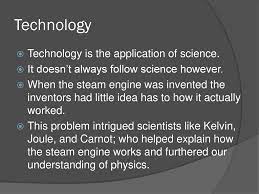Does Technology Always Follow Science?
Commonalities of process between science and technology
Although science and technology are related, the two fields are very different. Science deals with the systematic collection of knowledge while technology focuses on the application of that knowledge. While science focuses on the process of knowledge acquisition, technology focuses on the development of products that implement scientific principles. Ultimately, both science and technology aim to serve the needs of people by making their work easier and more efficient.
While science explores the physical world, engineering creates and applies knowledge to design, build, and test products and processes. As a result, science starts with a question, performs background research, formulates a hypothesis, conducts experiments, analyzes data, and communicates its findings. Engineers, on the other hand, start with a problem and brainstorm ideas to create a solution.
The two fields of study are fundamentally different, but they share several commonalities. In both fields, knowledge is the foundation of all creation. Science studies natural phenomena and uses that knowledge to make predictions and develop products. Technology builds on that foundation by using knowledge and creating new technologies to solve problems and create new products.
While science and technology are often viewed as separate, they are closely related. Both focus on the process of discovery and the ethical evaluation of data. Moreover, science requires strong decision-making, problem-solving, and communication skills. Its core goal is to understand nature and the universe.
The relationship between science and technology is mutually beneficial. Scientists use technology to advance humankind’s quality of life. For example, scientists study astronomy and astrophysics, while engineers develop fusion reactors. One scientist wants to develop a solution to the problem that affects the entire universe; the other wants to develop cheap energy. The process of invention and development is mutually dependent.
Commonalities of goals between science and technology
Although science and technology have many similarities, they also differ in many ways. In fact, Layton’s study of the two disciplines concludes that the similarities are superficial and the differences are more profound. Science is a way of learning and technology is a way of doing things. Both fields use experimental methods and apply knowledge to improve human lives.
Both branches of science seek to understand the natural world. While scientists attempt to answer questions about the physical world, engineers seek to create solutions for specific problems. They consider a variety of criteria in designing solutions for problems and wants. And both branches of science require critical thinking skills. The most fundamental goal of science is to understand the nature of the universe and how things work in it.
Technology, on the other hand, is a process of applying scientific knowledge to make a particular product or process. Both science and technology seek to improve the quality of life and raise the standard of living of humans and societies. For example, science studies how gravity affects the human body and uses it to create spaceships. Technology seeks to develop microwave ovens.
While science emphasizes facts and laws of nature, technology focuses on creating new technologies and techniques. Both are useful and can help humankind solve problems, but both can also be harmful to the world. The main difference between science and technology lies in their methods. While science tends to be immutable, technology constantly improves and changes.
Besides their differences, science and technology also have commonalities. The basic aim of science is to understand the natural world and predict future outcomes. Technology focuses on creating new systems that solve human needs. Technology focuses on improving the efficiency of human work, minimizing human suffering, and fulfilling human desires.
Science and technology share many goals. Both aim at improving the quality of life in societies. Their origins can be traced to ancient Mesopotamia and Egypt. They are both methods for exploring and implementing new knowledge, which can be useful or detrimental to society. Further, they both involve the use of new processes for making people’s lives easier.
Science and technology are fundamental to economic and social development. However, the ability to develop new scientific knowledge is unequally distributed throughout the world. Many development cooperation programs focus on developing countries’ research capacities. Unfortunately, these efforts are often limited to promoting knowledge transfers that involve a focus on scientists’ technical competencies and ignoring local political and social structures. This is largely responsible for the increasing scientific divide between developed and developing countries.
Design, on the other hand, is a process of creating products that people want to use. Design is the process of matching requirements with technology and creating new systems based on experience. This process is also a form of engineering that involves both macro and micro technologies and requires flexibility and methodology. It is the process of creating products that will improve people’s lives and the environment.
The CA approach enables us to consider the social context in which science and technology operate. As such, we can view science and technology as social goods. In addition, we can apply Sen’s CA framework to collectives. This approach also involves extending the concept of human rights to science and culture. Furthermore, it has implications for science policy and global research consortia.
Science and technology are both forms of learning and exploration. Both aim at improving life and providing new knowledge about the world. They both employ rigorous methods and include experiments to improve and understand natural phenomena. Branches of science include biology, chemistry, and physics. Researchers in these fields conduct research in research institutions, academic institutions, government agencies, and various science-based companies.
